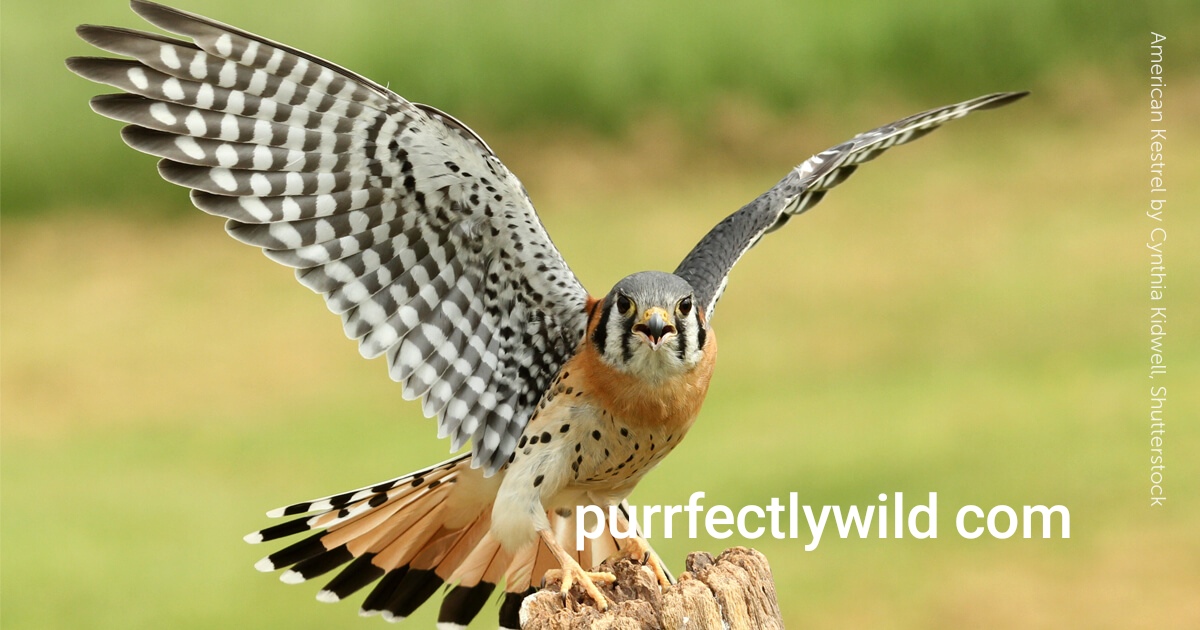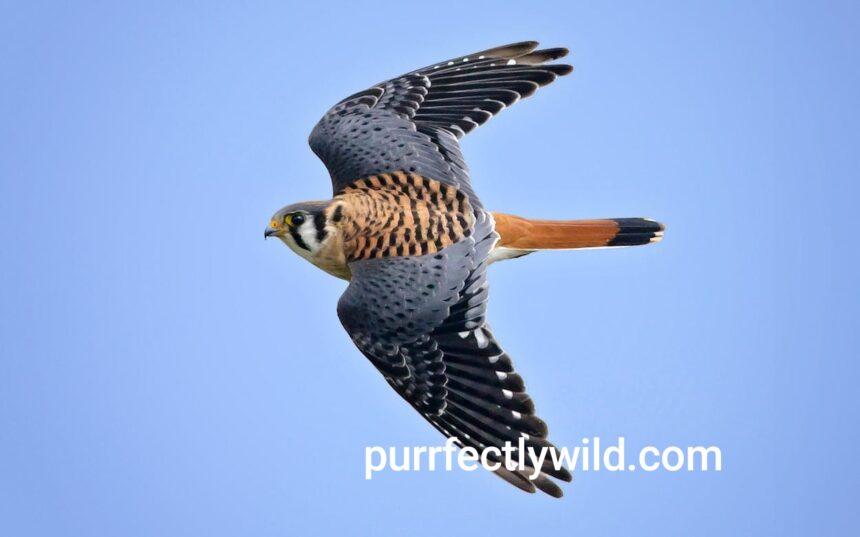1. Introduction
One of the most common and probably all-around vibrant bird-of-prey in western North America is The American Kestrel Falcon (Falco sparverius). More commonly referred to as the “sparrow hawk,” this diminutive falcon attracts attention because of its striking plumage and excellent abilities as a hunter. Seeing this bird is not unusual in various habitats, making it the cause of fascination for many who enjoy birds and those who study them alike. In this article, we will discover 18 interesting facts about the American Kestrel by exploring its habitat, physical traits, habits, and much more.

2. Habitat and Distribution
The American Kestrel is one of those broad species, as its habitat includes many kinds. Kestrels can adapt to various habitats, from open fields and grasslands in the Midwest to urban landscapes in significant cities.
Americas most Common
American Kestrels are found across the Americas. They are distributed throughout northern Alaska and Canada, all the way down to South America. They happily reside in temperate, tropical, and, in some cases, arid climates.
Preference for Open Spaces
Kestrels like open areas to see their prey from a distance. Birds of prey thrive in these habitats where open and agricultural, desert, and city parks are located to allow the birds to stay on for a moment or three while they use their super-sight scanning for something delicious. You might see them waiting atop fence posts, power lines, or tree limbs for small mammals or insects to make an appearance
3. Physical Characteristics
American Kestrels are impressive little predators for their size. Their adaptations in physical structure are ideal for repelling off the challenges they face when hunting and staying alive.
Size and Weight
American Kestrels are the littlest falcons in North America. They weigh around 80 to 165 grams with a wingspan of about 51–61 cm. They are small, fast flyers that shoot through the tree canopy to catch their insects.

Colorful Plumage
Color: Iconic to kestrels, these birds display some of the most distinctive plumage in North American raptors. Males have solid, black spots on their rust-colored back and slate-blue wings; females are more uniform reddish brown with dark bars. Both males and females have black vertical stripes across their faces, which can be an anti-glare deception when hunting in bright sunlight.
Sharp Vision and Talons
Kestrels can be found with sharp talons and an excellent sense of eyesight.anche sono dotati di lunghi artigli super affilaticonpressive prey at a distance. Their eyesight allows them to see ultraviolet light, which enables the hoary foxes to follow trails of urine laid down by small mammals.
4. Behavior and Diet
American Kestrel:
This is a small falcon. It has long wings and sometimes hovers while hunting insects or other small prey. It is white with black markings on the face and secondary. Its behavior and diet help us understand what it is in the ecosystem.

Hunting Techniques — Perch and Pounce
Kestrels often use a “perch and pounce” technique to catch their prey. They sit on high perches like utility poles or trees, watching for movement below. Once they spot their prey, they swoop down with incredible speed and precision.
Diverse Diet
Its diet may include insects, small mammals, birds, and reptiles. Its favorite prey include grasshoppers, crickets, voles, and mice. Its diet varies by season, depending on what is available for prey in its environment.
Hovering Ability
When it comes to hunting, the American Kestrel is one of the only birds that can hover in place. Kestrels can hover above the ground and beat their wings rapidly to stay airborne so they can scan for victims, which makes them unique from many birds of prey.
5. Reproduction
American Kestrels are monogamous during the breeding season, and their reproductive behavior is critical for maintaining populations of this species.
Nesting in Cavities
Unlike many other birds, Kestrels do not build their nest. They live in natural cavities of trees, cliffs and even artificial nest boxes. No nest-building is done, and their eggs are simply laid on the ground or surface.
Breeding Season and Courtship
American kestrels nest in early spring. They usually perform a sweep-over aerial demonstration to lure females by displaying their strength and agility. When a pair has formed, they stay together until the end of the breeding season, and the female lays three to seven eggs.
Parental Care
Both parents incubate the eggs, but the female does slightly more of the work. The eggs hatch after approximately 30 days, and both parents care for the chick until they fledge about a month later.
6. Conservation Status and Possible Threats
American Kestrels are adaptable and found throughout the United States but face various threats in some locations.
Conservation Status
The American Kestrel, listed globally as a species of “Least Concern” by the International Union for Conservation of Nature (IUCN), is still showing signs of regional decline across parts of its range, most notably in the northeastern United States.

Threats from Habitat Loss
Habitat loss, especially from urban sprawl and expanding farmlands, is among the greatest threats to kestrels. Open spaces and nesting sites have been destroyed, making it difficult for kestrels to find places suitable to live or breed.
Pesticides and Pollution
Another major threat to kestrels is the use of pesticides, which decreases prey numbers and results in poisoning. Kestrels are also threatened by pollution and climate change, which may affect their migratory movements and the availability of food.
7. Cultural Significance
Across different cultures, the American Kestrel has been honored and is symbolically vital for many societies.
Native American Symbolism
Kestrels are often considered to represent speed, agility, and diligence in Native American cultures. Their hunting ability and sharp intelligence made them warriors on certain occasions.
Falconry
For centuries, kestrels have been used in falconry. Because of their small size, intelligence, and hunting skills, kestrels are good at catching gamebirds, chicks, or insects such as grasshoppers.
8. Research and Studies
There has been a lot of American Kestrel research, particularly related to their conservation and behavior.
Citizen Science Projects
Some citizen science projects from different organizations study American Kestrels. Volunteers monitor nest boxes, follow population trends, and collect kestrel behavior and breeding success data. These efforts have generated a critical understanding of what challenges kestrel populations.
Tracking Migratory Patterns
Scientists use satellite tracking and banding programs to learn about American kestrels’ migratory behavior. This includes learning where they travel, what types of habitats they use, and how environmental factors relate to when the birds migrate.
9. Interesting Trivia
Unique Factors about the American KestrelThe: The special characteristics and general behavior of the kestrel have given it a very honored position among bird watchers and scientists. Some interesting snippets ….
Sexual Dimorphism
: A kestrel shows marked sexual dimorphism, meaning there are pronounced (as in the case of size) visible differences between males and females.
Eye Spots
: Kestrels have black spots positioned, also on the back of their heads like eyes. It has ‘false eyes’ that deter predators from nipping at them in the back.
Adaptable Hunters:
They are some of the only raptors that can hunt in urban and rural areas, modifying their hunting technique to fit the milieu.
10. Conclusion
Well, it is a remarkable bird of prey that I, along with many other people, admire for how attractive they are in appearance and talented during the hunt. Though populations in some parts of its range are stable, continued conservation efforts will maintain this pint-sized powerhouse as part of the natural world. When you see one perched on a power line or hovering in the sky, a Kestrel reminds us of all the beauty and complexity we hold within. Through ongoing study, preservation, and public education, we can preserve a fantastic creature for years to come.


